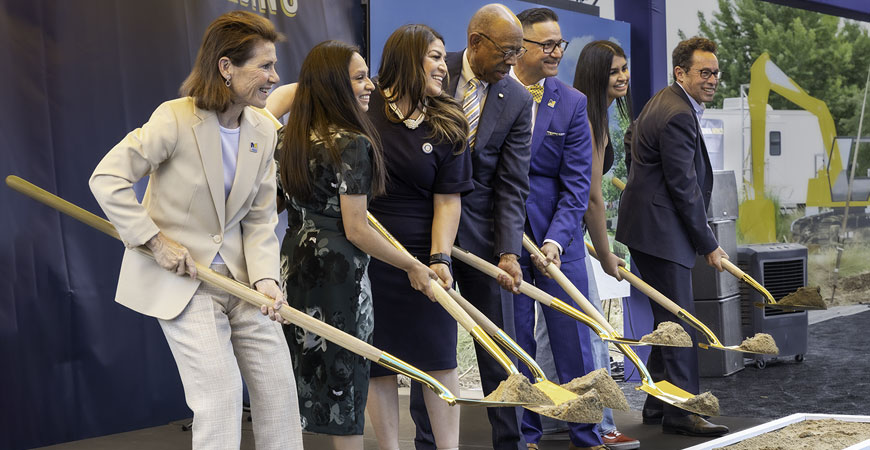
University of California and campus leaders broke ground Tuesday evening on a building to be constructed of steel, glass and Earth-friendly electronics.
But the Medical Education Building at UC Merced is also fashioned from decades of dreams and dedication of those determined to improve health access in the Central Valley.
The building will house its B.S.-to M.D.-pathway, aimed at producing doctors who will serve the local community. It also will house the university’s departments of psychology and public health, the Health Sciences Research Institute and a range of general assignment learning environments.
Related story: Following the Mission to Improve Valley Health Care
Four stories tall and 203,500 square feet, the structure will house instructional, academic office, research and community-facing space and common areas.
“Medical education had long been part of the plan for UC Merced since before we opened our doors to undergraduates in 2005,” Chancellor Juan Sánchez Muñoz said at Tuesday’s event. “It was very much a dream, but one far too long deferred until now.”
The urgency for medical education was driven by the critical lack of health care professionals in the Central Valley, a problem that has only grown since.
“We know from the research literature that medical professionals are far more likely to establish practices in the places where they were educated and undertook their residencies,” Muñoz said. “That is why our new medical education program — known as SJV PRIME PLUS — in partnership with UCSF and USCF-Fresno, is so important to the people and communities of the Central Valley.”
Last fall, UC Merced welcomed its first cohort of SJV PRIME+ students, all recruited from the Valley and committed to their families and their communities. The next cohort will be announced shortly.
One member of the first cohort, Sanmeet Deol, spoke at the groundbreaking.
“On behalf of my fellow classmates in the inaugural B.S.-M.D. pathway, we want you to know how excited we are to be the future doctors of the San Joaquin Valley,” she said. “We are all from the Valley and for the Valley and committed to serving those in need of quality health care in our respective communities throughout the San Joaquin Valley for generations to come.”
We are all from the Valley and for the Valley and committed to serving those in need of quality health care in our respective communities throughout the San Joaquin Valley for generations to come.
UC President Michael Drake said the program for students such as Doel has been “many, many decades in the making.”
Drake said the PRIME program began 20 years ago to train students with special expertise to provide medical care to people from challenging backgrounds. He said these programs have immediate and lasting effects on the campuses and surrounding areas.
“This kind of an impact will last for years.”
Other guests at the groundbreaking included local and state elected officials, donors, members of the medical community and UC representatives. The UC Board of Regents is in the middle of a three-day meeting at UC Merced, the first one held on the Merced campus. Attendees watched a video describing the program, examined a 3D rendering of the building, played health-related games and listened to speakers describe how momentous the event is.
“We are thrilled to see the groundbreaking begin at the new medical education facility at UC Merced,” said Dr. David Rubin, executive vice president of University of California Health. “Today’s groundbreaking ceremony is just the beginning of the opportunities that await future health professionals as they use the pathway programs spanning UC Merced, UCSF, UCSF-Fresno and Central Valley community colleges.
"UC Health is thankful for the years of collaboration with local and state leaders that led to this point, and we look forward to seeing the future physicians that will come through these doors and go on to provide high-quality care in their communities.”
Assemblywoman Esmeralda Soria, who represents the region, said she is the latest in a long line of public officials to support the effort to bring medical education to UC Merced.
“We know this region is one of the fastest-growing, poorest and least healthy,” she said. “We know our area has a longstanding shortage of physicians and other health care professionals. We know that what we are doing today is ensuring to have a better and brighter and healthier future for our entire region.”
The Medical Education Building is the latest advance at a university campus that has grown remarkably in size and stature since its own groundbreaking in October 2002.
“We make history in Merced every day — with every student whose success we propel, with every research project that pushes the bounds of knowledge, with every community engagement project that improves life in the Central Valley and California,” Muñoz said. “Today, we are writing more history — a history of greater education, broader research and more lives improved in the Valley and beyond.”



